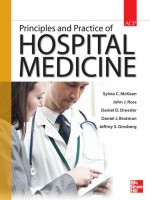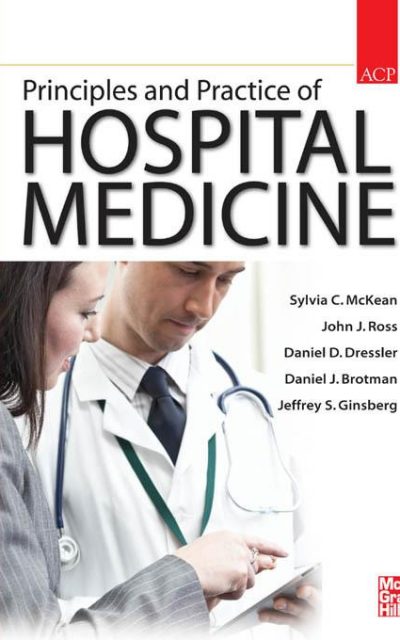 Editors: Sylvia C. McKean MD, John J. Ross MD, Daniel D. Dresser MD, Daniel J. Brotman MD, and Jeffrey S. Ginsberg MD
Editors: Sylvia C. McKean MD, John J. Ross MD, Daniel D. Dresser MD, Daniel J. Brotman MD, and Jeffrey S. Ginsberg MD
Publisher: McGraw-Hill – 2310 pages
Book Review by: Nano Khilnani
Hospital medicine as a specialty within the medical profession requires that its practice be safe, effective, patient-centered, timely, efficient, and equitable. These six dimensions have been spelled out by the Institute of Medicine in the United States, the editors point out in their Preface to this first edition of the unique, pioneering book.
This does not necessarily mean that physicians in private practice should not also be guided by these requirements any less. In the ongoing national debate on the annual soaring costs and quality of health care, both care providers and recipients demand that these requirements be met, more so now than in the past. The threat and incidence of lawsuits has grown, so it is imperative that everyone working in healthcare be vigilant.
This massive text of over two and a half inches in thickness and over 2300 pages covers virtually all aspects of hospital medicine, with 269 chapters allocated by specialty into 38 sections. The sections in turn are grouped under six parts, namely:
- The Specialty of Hospital Medicine and Systems of Care
- Medical Consultation and Co-Management
- Clinical Problem-Solving in Hospital Medicine
- Approach to the Patient at Bedside
- Hospitalist Skills
- Clinical Conditions
Some 450 medical specialists and experts in related fields contributed material to this collection that contains a huge volume of information. Most of the contributors work in hospitals and/or teach at medical schools in the United States and Canada.
The titles of the 38 sections typically relate to issues, items of specialized experience and knowledge, medical and surgical procedures and skills, and important values that physicians need to possess or acquire in order to practice their profession successfully in hospital settings. Below is an overview of what is covered in the sections:
Part I contains seven sections relating respectively to: key issues in hospital medicine; patient safety; quality improvement; leadership and practice management skills; professionalism and medical ethics; medical legal issues and risk management; and teaching and development.
Part II has eight sections dealing with the following subjects: core tenets of medical consultation; key issues relating to surgery; anesthesia; perioperative assessment and management; perioperative antithrombotic management and prevention; medical management of neurosurgical patients; medical management of orthopedic surgery patients; and bariatric surgery.
Parts III and IV do not contain any sections, but instead have 32 chapters together on topics that relate to clinical problem-solving and bedside approaches a host of medical problems ranging from acute pain to tachyarrhythmias.
Part V offers three sections focused on: interpretations of common tests; optimizing utilization of radiology services; and procedures.
Part VI has the most numerous sections: 20. Each one is on a given medical specialty, namely: emergency medicine; cardiovascular medicine; critical care: dermatology; endocrinology; gastroenterology; geriatrics; hematology; oncology; infectious disease; neurology; palliative care; pregnancy; psychiatry; addiction; pulmonary and allergy immunology; renal; rheumatology; vascular medicine; and wartime medicine.
The chapters start by helping you the student or practitioner focus on the chapter subject with a box entitled Key Clinical Questions – located right below the title and bylines. The material is presented in a simple format of two columns per page, except for other material such as data and images presented in separate boxes.
On the top right of the first page of each chapter is an Introduction. This is followed in logical order by headings such as Triage or Preparation, then by other headings such as Procedures and Medical Education, Ultrasound, etc. which equips you with knowledge to make the right decisions in the treatment of your patient.
Charts, data in boxes and tables, drawings, images, photographs, and other forms of presentation of information abound in each chapter. As a matter of fact there are more than 700 illustrations in this book.
This book is an authoritative source of guidance in the administrative, organizational areas of hospital medicine, as well as knowledge in its clinical aspects. The five editors, named below of this voluminous text have put in lots of hard work to make it a truly outstanding contribution, and we heartily commend them for it.
Sylvia C. McKean, MD, SFHM, FACP is Associate Professor of Medicine at Harvard Medical School in Boston, Massachusetts.
John J. Ross, MD, CM, FIDSA is Assistant Professor of Medicine at Harvard Medical School, and is in Hospitalist Service at Brigham and Women’s Hospital, both in Boston, Massachusetts.
Daniel D. Dressler, MD, MSc, SFHM is Associate Professor and Director of Education in the Section of Hospital Medicine, and Associate Director of the J. Willis Hurst Internal Medicine Residence Program at Emory University School of Medicine in Atlanta, Georgia.
Daniel J. Brotman, MD, FHM, FACP is Associate Professor of Medicine at the Johns Hopkins School of Medicine, and Director of the Hospitalist Program at Johns Hopkins Hospital in Baltimore, Maryland.
Jeffrey S. Ginsberg, MD, FRCP(C) is Professor of Medicine at McMaster University in Saint Joseph’s Hospital in Hamilton, Ontario, Canada.







